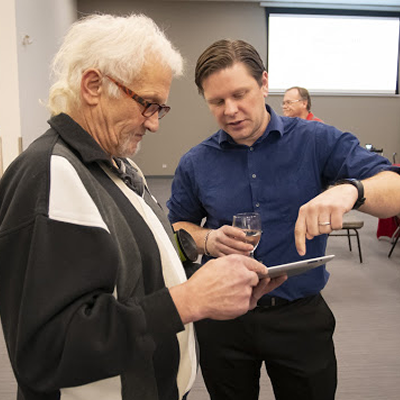Study documents impacts of tailings impoundment spill on Quesnel Lake

Prince George, BC –– A new research paper documents the physical and chemical characteristics, location, and extent of a sediment plume within Quesnel Lake for the first time since a mine tailings pond breach in August 2014, and discusses its initial and potential long term impacts on the Quesnel Lake ecosystem.
The paper, co-authored by five UNBC researchers and their collaborators, The impact of a catastrophic mine tailings impoundment spill into one of North America’s largest fjord lakes: Quesnel Lake, British Columbia, Canada, was published online by the journal Geophysical Research Letters on May 5.
UNBC scientists Ellen Petticrew, Phil Owens, Sam Albers, Stephen Déry, and Nikolaus Gantner collaborated closely with researchers at the University of British Columbia and the Department of Fisheries and Oceans (DFO) to produce this paper.
Researchers used historic in-lake mooring data, newly collected data, as well as publicly available information from the British Columbia Ministry of the Environment, Environment Canada, and the Mount Polley Mining Corporation to compare pre-breach conditions to changes in the lake following the catastrophic failure of the tailings impoundment on Aug. 4, 2014.
UNBC researchers were amongst the first on scene, owing to the proximity of the QRRC to the location of the breach.
“The advantage of having a strong group of scientists who were already collaborating on other projects in Quesnel Lake, was that we were able to respond quickly to implement sampling,” says lead author and UNBC Geography Professor Dr. Ellen Petticrew. “Knowledge of lake movement drives the chemical conditions which influences biological exposure is extremely important information for assessing and responding to an unplanned disaster of this scale and enabling us to evaluate the impact on the aquatic ecosystem.”
The study reporting on results from Aug. 4 through to Oct. 4 found:
• A lake level rise of 7.7 centimetres was accompanied by a temperature increase of 1 to 2.5 C at the bottom of the lake.
• The turbidity of the water column was increased in the West Arm of Quesnel Lake, indicating the existence of a sediment plume at depths below 30 metres.
• Ultra-fine sediments remained suspended (394 cubic metres representing a surface area of about 1,000 square kilometres).
• The rocking of the water column, or seiching, redirected the plume towards the North and East Arms of Quesnel Lake, as well as towards the lake outflow, Quesnel River.
• Copper concentrations in sediment samples collected from Quesnel Lake and Quesnel River are elevated, often above sediment quality guidelines for freshwater ecosystems.
The researchers also identify knowledge gaps and stress the need for continued monitoring to determine what lessons can be learned.
“UNBC researchers from the Prince George campus and the Quesnel River Research Centre led the way by acting immediately to study the impact of the tailings pond breach,” says UNBC President Dr. Daniel Weeks. “Ongoing analysis is crucial and UNBC researchers are committed to thoroughly investigating Quesnel Lake and documenting the post-spill environment.”
The study involved close cooperation with scientists from across British Columbia and involved graduate students and technicians. It was supported by Forest Renewal BC, DFO, UBC, and UNBC.
BACKGROUNDER
Quotes from additional researchers are available.
UNBC researcher Phil Owens:
“We were all shocked by what happened; even now it is difficult to come to terms with. I draw some comfort from the fact that the research community – many of whom were already actively involved studying Quesnel watershed – have come together to work with local organizations in order to understand what this event means for the ecosystem and local communities. We will be involved in research which attempts to understand the implications of this disaster for many years to come; what we need is financial and logistic support.”
QRRC manager Sam Albers:
“Our ability to respond so quickly to this event was due, in large part, to the active research taking place on the Quesnel watershed out of the Quesnel River Research Centre prior to breach. Equipment, infrastructure and people were already in place at QRRC on Aug. 4 and responding to the event consisted of diverting time and resources towards this issue. Additionally, over the long term the QRRC will serve as a scientific and logistical hub for research activities surrounding the Mount Polley tailings pond breach.”
UNBC researcher Stephen Déry:
“Access to near-real time meteorological data from three weather stations in the vicinity of Likely, BC greatly assisted in understanding the atmospheric controls on the sediment plume dispersion and seiching events in Quesnel Lake. There is a paucity of in-situ meteorological stations in the Quesnel River watershed and so infrastructure developed and maintained as part of the so-called Cariboo Alpine Mesonet proved immensely useful to interpret the catastrophic events of the Mt. Polley tailing pond spill.”
Nikolaus Gantner, Environmental Toxicologist and Adjunct Professor at UNBC:
“Evidently, a mix of mine wastes and natural sediments has entered a pristine lake ecosystem that is home to highly value salmonid species. So what? Were there acute effects on the biological communities that support fish and fisheries in Quesnel Lake, or is the lake resilient to such events? Can we expect long term effects as some materials make it into and up the food web?”
Nikolaus Gantner, Environmental Toxicologist and Adjunct Professor at UNBC:
“Fortunately, UNBC has facilities (QRRC) and expertise to address these urgent questions in collaboration with our partners. It is critical to continue research on Quesnel Lake and adjacent ecosystems to be able to fully understand responses of the ecosystem to this event, which can provide valuable lessons for the future.”




